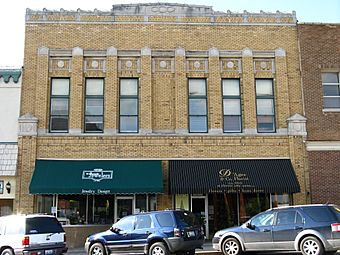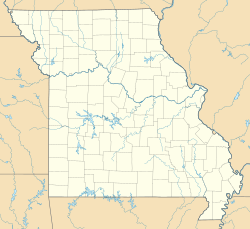IOOF Liberty Lodge No. 49 facts for kids
Quick facts for kids |
|
|
IOOF Liberty Lodge No. 49
|
|

The lodge, seen from East Franklin Street
|
|
| Location | 16--18 E. Franklin St., Liberty, Missouri |
|---|---|
| Area | less than one acre |
| Built | 1923 |
| Built by | Miller-Stauch Construction Co. |
| Architect | Charles A. Smith |
| Architectural style | Moderne, Early 20th-century commercial |
| MPS | Liberty MPS |
| NRHP reference No. | 92001677 |
| Added to NRHP | December 28, 1992 |
The IOOF Liberty Lodge No. 49 is a special old building in Liberty, Missouri. It was built in 1923. For many years, it was used as a meeting place for a group called the Independent Order of Odd Fellows. It also had shops on the first floor. Because it's an important part of history, it was added to the National Register of Historic Places in 1992.
A Place for Meetings and Shops
The Independent Order of Odd Fellows is a friendly group that helps people. In Liberty, this group needed a bigger place for their meetings. They already had a building nearby. So, in 1923, they built this new lodge at 16-18 East Franklin Street.
Like their first building, the Odd Fellows rented out the ground floor of this new building to businesses. They used the second floor as their meeting hall. Their older building then became a place for banquets and special meals.
The shop at 16 East Franklin has been home to Whiteside Jewelry since the 1920s. The other shop space in the building has also had long-term tenants. These included a variety store and a flower shop.
What the Building Looks Like
The Liberty Lodge building is a two-story structure made of brick. It has a flat roof and a special top edge called a parapet. The building is covered in light-colored, shiny bricks.
Right in the middle of the parapet, you can see the Odd Fellows' special symbol carved into the stone. This symbol is made of three interlocking rings. The second floor, where meetings used to happen, has been changed into several small offices.
Designed by a Famous Architect
The building's style is called Moderne architecture and early 20th-century commercial. This means it has a clean, modern look for its time. It was designed by a well-known architect named Charles A. Smith.
Smith was famous in the Kansas City area. He designed more than fifty schools. He also designed some buildings at William Jewell College in Liberty.
The building was added to the National Register of Historic Places for two main reasons. First, it shows how buildings in small towns often had different uses, like shops and meeting halls. Second, it's important because of its connection to the architect Charles A. Smith.



